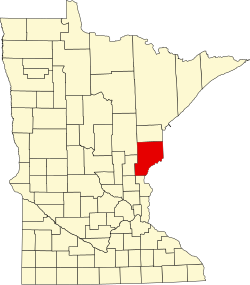Pine County | |
|---|---|
 Pine County Courthouse, Pine City | |
 Location within the U.S. state of Minnesota | |
 Minnesota's location within the U.S. | |
| Coordinates: 46°08′N92°44′W / 46.14°N 92.74°W | |
| Country | |
| State | |
| Founded | March 1, 1856 (created) 1872 (organized) [1] |
| Named after | The abundant pine trees in the area |
| Seat | Pine City |
| Largest city | Pine City |
| Area | |
• Total | 1,435 sq mi (3,720 km2) |
| • Land | 1,411 sq mi (3,650 km2) |
| • Water | 23 sq mi (60 km2) 1.6% |
| Population (2020) | |
• Total | 28,876 |
• Estimate (2024) | 30,319 |
| • Density | 20/sq mi (7.8/km2) |
| Time zone | UTC−6 (Central) |
| • Summer (DST) | UTC−5 (CDT) |
| Congressional district | 8th |
| Website | www |
Pine County is a county in the U.S. state of Minnesota. As of the 2020 census, the population was 28,876. [2] Its county seat is Pine City. [3] The county was formed in 1856 and organized in 1872. Today, Pine County is the fastest growing county in the state. [4] [5] Part of the Mille Lacs Indian Reservation is in Pine County.

